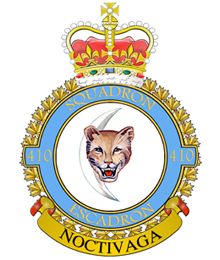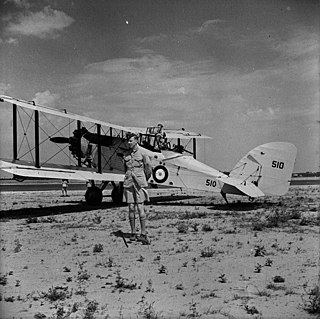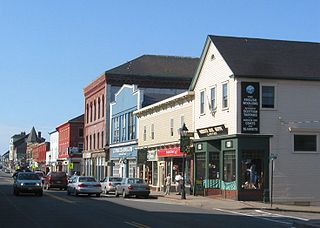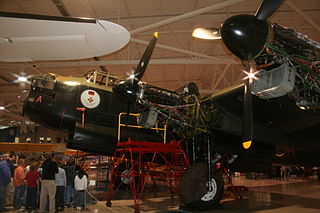The history of the Royal Canadian Air Force begins in 1920, when the air force was created as the Canadian Air Force (CAF). In 1924 the CAF was renamed the Royal Canadian Air Force (RCAF) when it was granted the royal title by King George V. The RCAF existed as an independent service until 1968. Prior attempts at forming an air force for Canada were the Canadian Aviation Corps that was attached to the Canadian Expeditionary Force, and a two-squadron Canadian Air Force that was attached to the Royal Air Force.

Canadian Forces Base Greenwood, or CFB Greenwood, is a Canadian Forces Base located 1.5 nautical miles east of Greenwood, Nova Scotia. It is primarily operated as an air force base by the Royal Canadian Air Force and is one of two bases in the country using the CP-140 Aurora and CP-140A Arcturus anti-submarine/maritime patrol and surveillance aircraft. Its primary RCAF lodger unit is 14 Wing, commonly referred to as 14 Wing Greenwood.

Yarmouth Airport is located in Yarmouth County, Nova Scotia, Canada. It began as a World War II Royal Air Force training base.

The Bristol Fairchild Bolingbroke was a maritime patrol aircraft and trainer used by the Royal Canadian Air Force during the Second World War. Built by Fairchild-Canada, it was a license-built version of the Bristol Blenheim Mk IV bomber.

442 Transport and Rescue Squadron is a Royal Canadian Air Force tactical transport and search and rescue unit based at Canadian Forces Base (CFB) Comox in the Canadian province of British Columbia. The squadron flies six De Havilland Canada CC-115 Buffalo STOL aircraft and five AgustaWestland CH-149 Cormorant rescue helicopters. One of each is on constant readiness to deploy in response to distress calls in the Victoria Search and Rescue Region, which includes most of British Columbia and the territory of Yukon as well as 560,000 square kilometres in the Pacific Ocean, up to 600 nm offshore. The squadron also serves as the Operational Training Unit for the CH-149 Cormorant helicopter and the CC-115 Buffalo airplane.
The Royal Air Force (RAF) and Fleet Air Arm (FAA) had included personnel from outside the United Kingdom from before the beginning of the Second World War and many served in the Battle of Britain in 1940. Many were volunteers from the British Empire, refugees and exiles from German-occupied Europe, and American emigrants.

No. 7 Squadron was an Australian flying training squadron of World War I and medium bomber squadron of World War II. The squadron was formed in England in October 1917 as part of the Australian Flying Corps, and disbanded in early 1919. It was re-formed by the Royal Australian Air Force on paper in June 1940, and operationally in January 1942. After seeing action during the Pacific War flying Lockheed Hudson and, later, DAP Beaufort bombers, the squadron was disbanded a second time in December 1945.

403 "City of Calgary" (Helicopter) Operational Training Squadron is a squadron of the Royal Canadian Air Force (RCAF) located at Canadian Forces Base Gagetown. It is equipped with CH-146 Griffons and provides operational aircrew training to the crews who will fly the helicopter. The squadron also conducts operational test and evaluation, develops aviation tactics and carries out operations in support of the 1 Wing mission. It also supports the local Army requirements of the Combat Training Centre. It was founded as No. 403 Squadron RCAF.

No. 428 Squadron RCAF, also known as 428 Bomber Squadron, and 428 Ghost Squadron, was first a night bomber squadron in the Royal Canadian Air Force engaged in strategic bombing during World War II, as based in Yorkshire. At the end of the war the squadron moved to Nova Scotia before being disbanded in September 1945. In 1954 the squadron was reformed as 428 All-Weather (Fighter) Squadron, before being again disbanded in 1961.

410 Tactical Fighter Operational Training Squadron, nicknamed the "Cougars", is a Royal Canadian Air Force aircraft squadron currently located at Canada's primary training base for the CF-18, at Cold Lake, Alberta. The squadron was formed during the Second World War as an RCAF squadron under the Royal Air Force (RAF), at RAF Ayr, near Prestwick, in Scotland.

No. 401 Tactical Fighter Squadron, a.k.a. "City of Westmount" Squadron, is a Royal Canadian Air Force squadron based at CFB Cold Lake. During World War II it was a fighter squadron and is notable for having fought in the Battle of Britain. Postwar, the squadron operated in Canada as an auxiliary squadron, reserve squadron and a helicopter and training squadron. In 2015 it was reactivated as a Tactical Fighter Squadron.

No. 162 Squadron RCAF was a unit of the Royal Canadian Air Force. Formed as a bomber reconnaissance squadron at RCAF Station Yarmouth, Nova Scotia, Canada on 19 May 1942 with Canso A aircraft, the squadron spent an uneventful eighteen months on east coast anti-submarine duty. In January 1944 it was seconded to RAF Coastal Command and stationed at RAF Reykjavik, Iceland to cover the mid-ocean portion of the North Atlantic shipping route.

No. 115 Squadron was a Royal Canadian Air Force Canadian Home War Establishment (HWE) Squadron. It flew anti-submarine patrols on the British Columbian and Alaskan coasts as part of Western Air Command. On 7 July 1942, F/Sgt. PMG Thomas and the crew of his Bollingbroke attacked the Japanese submarine Ro32 damaging it badly and they then directed U.S. Destroyers to the scene which sunk it. The squadron disbanded at Tofino, British Columbia in August 1944.
No. 4 Squadron was a Royal Canadian Air Force squadron that was active during the Second World War. It was formed on 17 January 1933 at RCAF Station Jericho Beach and flew civil operations until 1939. During the war it was primarily used in an anti-submarine role with Western Air Command and was based at Tofino, British Columbia. The squadron flew the Blackburn Shark, Supermarine Stranraer, Consolidated Canso and Consolidated Catalina before disbanding on 7 August 1945.
No. 6 Squadron was a Royal Canadian Air Force squadron that was active during the Second World War.
Eastern Air Command was the part of the Royal Canadian Air Force's Home War Establishment responsible for air operations on the Atlantic coast of Canada during the Second World War. It played a critical role in anti-submarine operations in Canadian and Newfoundland waters during the Battle of the Atlantic. Eastern Air Command also had several fighter squadrons and operational training units under its umbrella.
No. 116 Squadron was a Royal Canadian Air Force squadron that was active during the Second World War. It was originally formed as a Coast Artillery Co-operation squadron and then a fighter squadron before being disbanded in 1939, and then reformed in 1941. It was primarily used in an anti-submarine role and was based at Dartmouth and Sydney, Nova Scotia and Gander, Newfoundland. The squadron flew the Catalina and Canso before disbanding on 20 June 1945.

No. 3 (Bomber) Squadron was a Royal Canadian Air Force (RCAF) squadron active during the late 1930s.






















